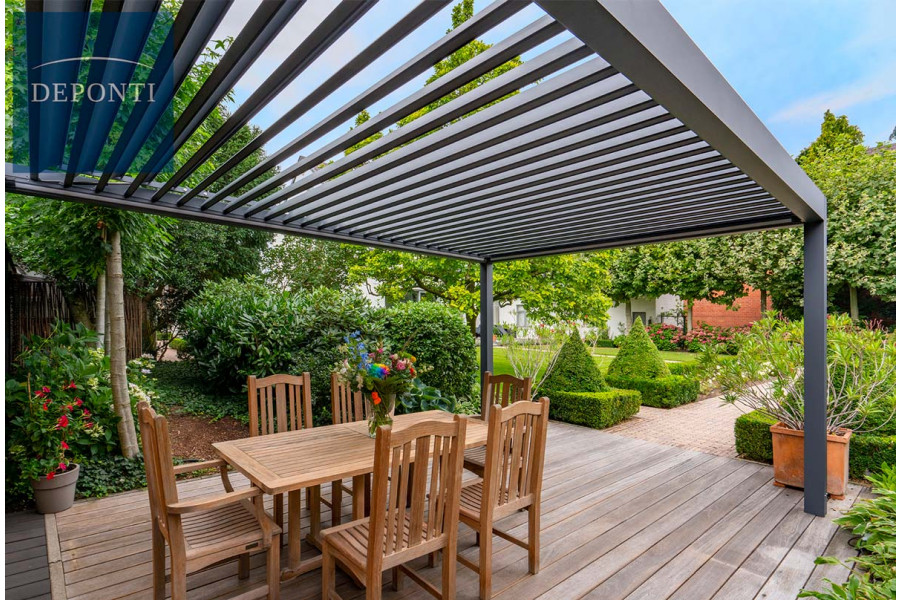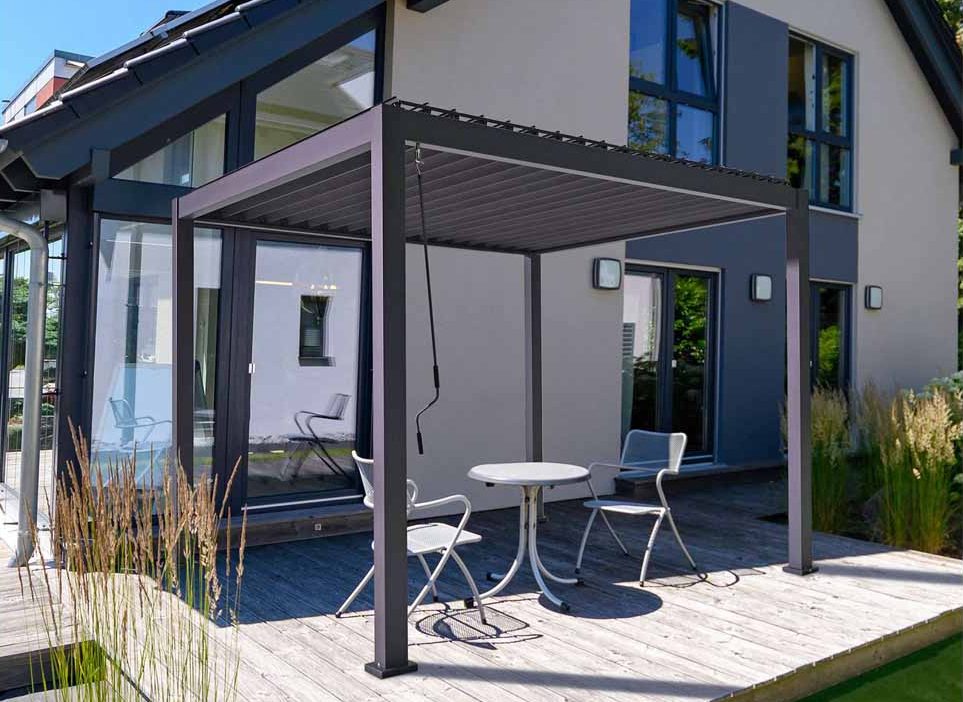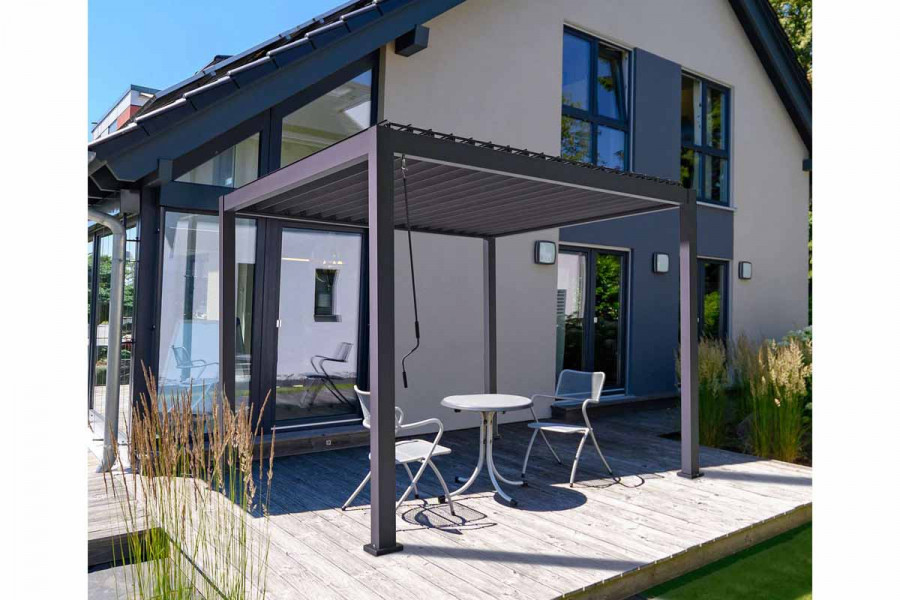As an increasingly popular addition to gardens in the UK, pergolas are not actually a new design structure. You’ve no doubt seen a pergola at some point, but you may not have appreciated how different they can be until you started considering one for your garden.
This month at London Stone, we’ve created a buyer’s guide for anyone looking to collect all the facts and information on pergolas. This way you can make an informed decision on the right product for your garden.
Let’s start with a definition of what a pergola is for anyone who might be unsure.
What Is A Pergola?
The name pergola actually has its roots in Latin. ‘Pergula’ essentially means a projected roof, and that’s really what a pergola is, just with varied formats. Most commonly you see pergolas used as freestanding structures - although, as you’ll learn in our next section, they can attach to existing buildings. They often comprise several beams in an arch formation at intervals and can be used to grow climbing plants. These structures can sometimes be topped by a roof or left open if they’ve been erected for the purpose of encouraging climbing plants.
The Different Types Of Pergolas
Pergolas are a relatively simple, yet elegant structural feature, but there are a few variations of this class that you should probably familiarise yourself with if you’re considering one.
- Free-standing - The most recognisable pergola is the free-standing one, with at least four vertical beams fixed to the floor and joined with horizontal overhead beams.
- Lean-to - As the Latin origins of the word suggest, a lean-to pergola is essentially one that connects as a permanent awning to the side of a building.
- Collapsible - Much like an ordinary free-standing pergola but less permanent, a collapsible pergola is something you can take down and store - often more convenient for commercial usage where different outdoor events require different infrastructure.
- Bioclimatic - Taking pergolas one step further, these will usually feature adjustable roof louvres to provide control of temperature, lighting and ventilation. Some may even come with panels to adjust along the side to create a more contained pergola space.
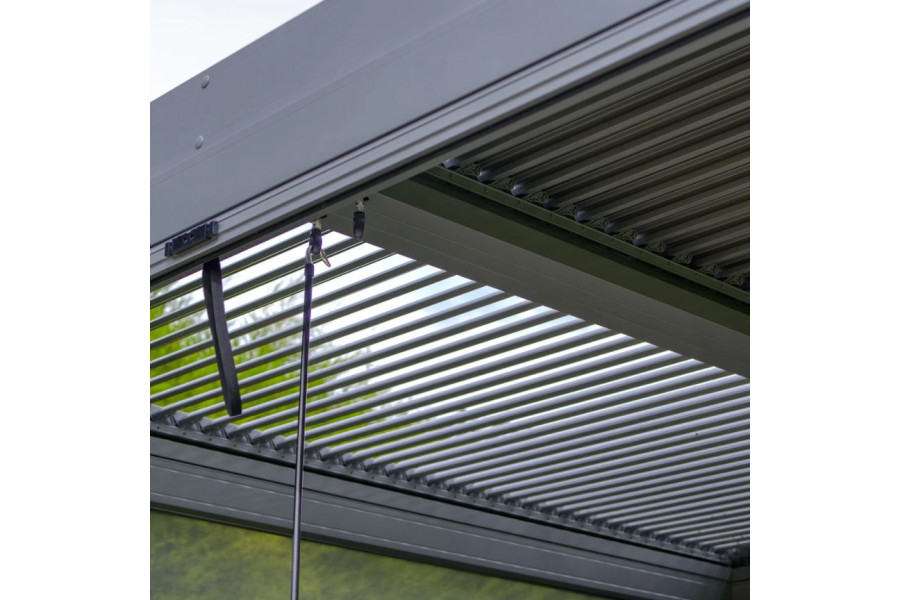
These pergola styles, along with the size you have in mind, will also need to be factored into the positioning of your structure.
Many people choose to situate them on their patio, close to the home to create a seamless extension into their outdoor space. Others, where the space is available, use a pergola to create a separate seating area away from the house to add an extra, practical space to the garden.
Pergola Material
The longevity and stability of your pergola comes from both the material it’s made of and how it is fixed into place, so let’s look at the three most common material types:
- Wood - A natural look that may complement your decking or fencing, but you will need to treat it regularly to ensure it doesn’t slowly decay and diminish over the years.
- Plastic - Will last longer than wood but depending on quality any colour could fade. Less stable in high winds and may not stand up to any impacts as well as metal.
- Metal - The ultimate combination of stability and longevity, but without compromising on style for your garden. View our metal pergola range.
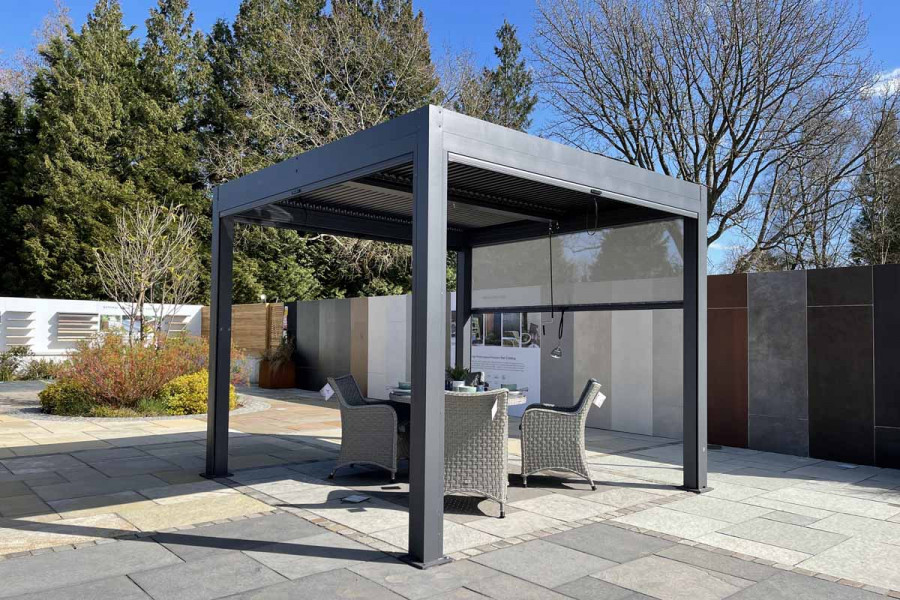
When it comes to fixings, there are several ways you can install your pergola, but it will probably depend on positioning, the materials the pergola is built with and how permanent you wish to make the feature.
The two main options are to bolt or screw the vertical beams to the ground or to sink the posts in the ground with concrete. The latter will create a more permanent feature and can allow you to tile around the beams.
Roof Styles
We’ve touched briefly on roof styles, but let’s delve a little deeper and look at the options for pergola roofs:
- Enclosed roofs - These roofs allow you to open and close the roof of your pergola to create more shelter
- Open roofs - To keep a sense of the open air, this option is great, but it can only really be practical to sit under in summer
- Fabric roofs - Much like a parasol, adding fabric across the top of your beams creates something more like a shade sail, providing a little more shade and shelter than an open roof.
With our metal pergolas at London Stone, you can get the luxury of an adjustable roof, as well as walls that slide down for added protection and stability. Alternatively, our shade sails provide a semi-permanent option for relaxing or hosting outdoors.
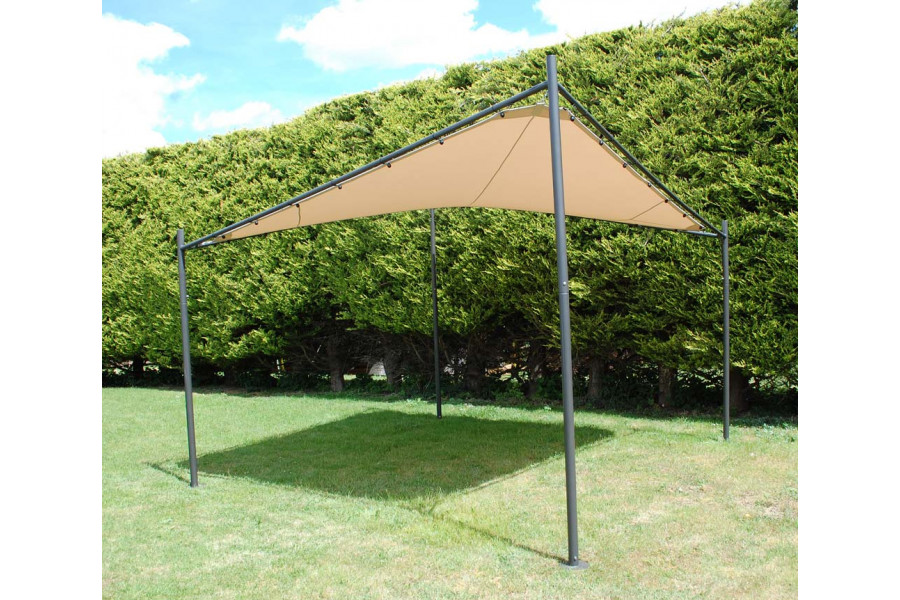
Cost
As you’ve probably already realised from this guide, pergolas can come in many shapes, sizes and materials. From the simple to the luxurious, there is always an option to suit your garden and your budget.
The price you’re willing to pay will inform how long your pergola lasts and how good it looks. A small, wooden pergola is a cheap solution, but it may require more maintenance over time and will probably need to be replaced within a few years. At the other end of the spectrum, a metal pergola with an adjustable roof and side walls may cost more but will stand the test of time, making it a better investment for your property in the long term.
Our sales team is always happy to help if you have any questions or need any more information about our pergolas, so please don’t hesitate to contact us.


/filters:quality(60)/mediadev/media/menu-pics/all-porcelain.jpg )
/filters:quality(60)/mediadev/media/menu-pics/luxury-italian.jpg )
/filters:quality(60)/mediadev/media/menu-pics/premium-italian.jpg )
/filters:quality(60)/mediadev/media/menu-pics/budget-porcelain.jpg )
/filters:quality(60)/mediadev/media/menu-pics/large-format-porcelain.jpg )
/filters:quality(60)/mediadev/media/menu-pics/wood-effect-porcelain.jpg )
/filters:quality(60)/mediadev/media/menu-pics/porcelain-planks.jpg )
/filters:quality(60)/mediadev/media/menu-pics/porcelain-setts.jpg )
/filters:quality(60)/mediadev/media/menu-pics/browse-all-paving.jpg )
/filters:quality(60)/mediadev/media/menu-pics/stone-paving.jpg )
/filters:quality(60)/mediadev/media/menu-pics/interior-tiles.jpg )
/filters:quality(60)/mediadev/media/menu-pics/stone-effect-porcelain.png )
/filters:quality(60)/mediadev/media/menu-pics/wood-effect-porcelain.png )
/filters:quality(60)/mediadev/media/menu-pics/grey-porcelain.png )
/filters:quality(60)/mediadev/media/menu-pics/beige-porcelain.png )
/filters:quality(60)/mediadev/media/menu-pics/dark-porcelain.png )
/filters:quality(60)/mediadev/media/menu-pics/light-porcelain.png )
/filters:quality(60)/mediadev/media/menu-pics/patio-grout.jpg)
/filters:quality(60)/mediadev/media/menu-pics/primers.jpg)
/filters:quality(60)/mediadev/media/menu-pics/porcelain-blades.jpg)
/filters:quality(90)/mediadev/media/menu-pics/drainage.jpg)
/filters:quality(60)/mediadev/media/menu-pics/cleaners.jpg)
/filters:quality(60)/mediadev/media/menu-pics/all-stone-paving.jpg )
/filters:quality(60)/mediadev/media/menu-pics/all-sawn-paving.jpg )
/filters:quality(60)/mediadev/media/menu-pics/all-riven-paving.jpg )
/filters:quality(60)/mediadev/media/menu-pics/indian-sandstone.jpg )
/filters:quality(60)/mediadev/media/menu-pics/limestone-paving.jpg )
/filters:quality(60)/mediadev/media/menu-pics/granite-paving.jpg )
/filters:quality(60)/mediadev/media/menu-pics/slate-paving.jpg )
/filters:quality(60)/mediadev/media/menu-pics/yorkstone-paving.jpg )
/filters:quality(60)/mediadev/media/menu-pics/stone-pavers.jpg )
/filters:quality(60)/mediadev/media/menu-pics/cobbles-setts.jpg )
/filters:quality(60)/mediadev/media/menu-pics/plank-paving.jpg )
/filters:quality(60)/mediadev/media/menu-pics/paving-circles.jpg )
/filters:quality(60)/mediadev/media/menu-pics/bespoke-paving-1.jpg )
/filters:quality(60)/mediadev/media/menu-pics/edging-stones-1.jpg )
/filters:quality(60)/mediadev/media/menu-pics/prestige-stone.jpg )
/filters:quality(60)/mediadev/media/menu-pics/grey-blue-stone.png)
/filters:quality(60)/mediadev/media/menu-pics/swatch-black-dark.jpg )
/filters:quality(60)/mediadev/media/menu-pics/swatch-buff-beige-white.jpg )
/filters:quality(60)/mediadev/media/menu-pics/sealants.jpg)
/filters:quality(60)/mediadev/media/menu-pics/all-clay-paving.jpg )
/filters:quality(60)/mediadev/media/menu-pics/alpha-clay-pavers.jpg )
/filters:quality(60)/mediadev/media/menu-pics/cottage-garden-clay-pavers.jpg )
/filters:quality(60)/mediadev/media/menu-pics/kessel-garden-clay-pavers.jpg )
/filters:quality(60)/mediadev/media/menu-pics/artisan-clay-pavers.jpg )
/filters:quality(60)/mediadev/media/menu-pics/grey-blue-clay-paver.png )
/filters:quality(60)/mediadev/media/menu-pics/red-brown-clay-pavers.png )
/filters:quality(60)/mediadev/media/menu-pics/beige-buff-clay-pavers.png )
/filters:quality(60)/mediadev/media/menu-pics/composite-decking.jpg )
/filters:quality(60)/mediadev/media/menu-pics/designboard-decking.jpg )
/filters:quality(60)/mediadev/media/menu-pics/classic-designboard.jpg )
/filters:quality(60)/mediadev/media/menu-pics/brushed-designboard.jpg )
/filters:quality(60)/mediadev/media/menu-pics/grooved-designboard.jpg )
/filters:quality(60)/mediadev/media/menu-pics/millboard-decking.jpg )
/filters:quality(60)/mediadev/media/menu-pics/grey-decking.jpg )
/filters:quality(60)/mediadev/media/menu-pics/black-charcoal-decking.jpg)
/filters:quality(60)/mediadev/media/menu-pics/brown-decking.jpg)
/filters:quality(60)/mediadev/media/menu-pics/all-build-deck.png )
/filters:quality(60)/mediadev/media/menu-pics/stone-cladding.jpg )
/filters:quality(60)/mediadev/media/menu-pics/all-garden-walling-1.jpg )
/filters:quality(60)/mediadev/media/menu-pics/facing-bricks.jpg )
/filters:quality(60)/mediadev/media/menu-pics/garden-screening.jpg )
/filters:quality(60)/mediadev/media/menu-pics/all-steps-coping.jpg )
/filters:quality(60)/mediadev/media/menu-pics/stone-garden-steps.jpg )
/filters:quality(60)/mediadev/media/menu-pics/sawn-steps.jpg )
/filters:quality(60)/mediadev/media/menu-pics/riven-steps.jpg )
/filters:quality(60)/mediadev/media/menu-pics/yorkstone-steps.jpg )
/filters:quality(60)/mediadev/media/menu-pics/bespoke-steps.jpg )
/filters:quality(60)/mediadev/media/menu-pics/porcelain-steps.jpg )
/filters:quality(60)/mediadev/media/menu-pics/off-the-shelf.jpg )
/filters:quality(60)/mediadev/media/menu-pics/stone-coping.jpg )
/filters:quality(60)/mediadev/media/menu-pics/sawn-coping.jpg )
/filters:quality(60)/mediadev/media/menu-pics/riven-coping.jpg )
/filters:quality(60)/mediadev/media/menu-pics/yorkstone-coping.jpg )
/filters:quality(60)/mediadev/media/menu-pics/bespoke-coping.jpg )
/filters:quality(60)/mediadev/media/menu-pics/stone-pier-caps.jpg )
/filters:quality(60)/mediadev/media/menu-pics/porcelain-coping.jpg )
/filters:quality(60)/mediadev/media/menu-pics/all-bespoke-services.jpg )
/filters:quality(60)/mediadev/media/menu-pics/bespoke-paving-2.jpg )
/filters:quality(60)/mediadev/media/menu-pics/bespoke-steps-1.jpg )
/filters:quality(60)/mediadev/media/menu-pics/bespoke-coping-1.jpg )
/filters:quality(60)/mediadev/media/menu-pics/edge-profiles.jpg )
/filters:quality(60)/mediadev/media/menu-pics/masonry-services.jpg )
/filters:quality(60)/mediadev/media/menu-pics/deluxe-pergolas.jpg )
/filters:quality(60)/mediadev/media/menu-pics/proteus-pergolas.jpg )


